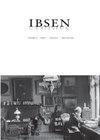Nietzschean Variations: Politics, Interest, and Education in Ibsen's An Enemy of the People
IF 0.1
0 THEATER
引用次数: 7
Abstract
Henrik Ibsen’s An Enemy of the People (1882) has had an unusual reception. Following A Doll’s House (1879) andGhosts (1881), plays that were scandalized upon performance only to be counted, relatively soon, among Ibsen’s most important works, An Enemy of the Peoplewas caught up by history in a different way. While the play has, no doubt, enjoyed bouts of popularity – including the many stagings that followed in thewake of its publication – late twentieth-centurycritics have worried about the political implications of Dr. Stockmann’s elitism and sometimes even compared it to the rhetoric of the later Nationalist Socialistmovement inGermany (Sage 2006, 3–5, 310–311; Ferguson 1996, 280ff ). The kind of elitist sentiments Dr. Stockmann airs inAn Enemy of the People are often associated with the teaching of Friedrich Nietzsche. Nietzsche’s work was much debated and discussed in Scandinavia when Ibsen was working on the play. Thus, critics have emphasized how Ibsen’s play resonates with a kind of aristocratic pathos that is not unlike the onewe find inwork of theGerman philosopher.While such a reading was prefigured in an essay by Anathon Aall at the beginning of the Twentieth Century, we findmore recent versions of the argument in works by Noreng (1969), de Figueiredo (2007) and Kittang (2005). In his reading ofAn Enemy of the People, Kittang speaks Ibsen Studies, 2014 Vol. 14, No. 2, 109–135, http://dx.doi.org/10.1080/15021866.2014.1000659尼采变体:易卜生《人民公敌》中的政治、利益与教育
易卜生的《人民公敌》(1882)受到了不同寻常的欢迎。继《玩偶之家》(1879)和《鬼》(1881)两部剧之后,《人民公敌》(An Enemy of the people)以一种不同的方式被历史所关注,这两部剧在表演上受到了谴责,但很快就被列入易卜生最重要的作品之列。毫无疑问,这部戏剧受到了广泛的欢迎,包括在它出版后的许多舞台上,20世纪末的评论家们担心斯托克曼博士的精英主义的政治含义,有时甚至将其与后来的德国民族社会主义运动的修辞相比较(Sage 2006, 3-5, 310-311;Ferguson 1996, 280ff)。斯托克曼博士在《人民公敌》中所宣扬的那种精英主义情绪,常常与弗里德里希·尼采的学说联系在一起。当易卜生创作这部戏剧时,尼采的作品在斯堪的纳维亚引起了很多争论和讨论。因此,评论家们强调易卜生的戏剧是如何与一种贵族的悲怆产生共鸣的,这种悲怆与我们在这位德国哲学家的作品中发现的悲怆并没有什么不同。虽然在20世纪初,Anathon Aall在一篇文章中预言了这种解读,但我们在Noreng(1969)、de Figueiredo(2007)和Kittang(2005)的作品中发现了这种观点的最新版本。《易卜生研究》,2014年第14卷第2期,109-135页,http://dx.doi.org/10.1080/15021866.2014.1000659
本文章由计算机程序翻译,如有差异,请以英文原文为准。
求助全文
约1分钟内获得全文
求助全文

 求助内容:
求助内容: 应助结果提醒方式:
应助结果提醒方式:


